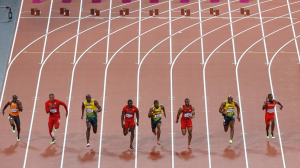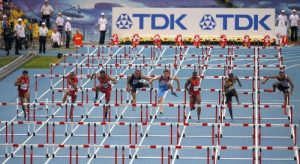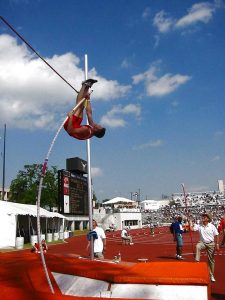What is the oldest sport in the world? -asked the Professor.
A silence filled the hall… That question had nothing to do with quantum physics!
In a sprint race, athletes run from one side to the other without experiencing any obstacle; therefore, to describe the race we just need to know the momentum of each athelete, which will indicate the mass and velocity.

As shown in Figure 1, in a 100-meter sprint competition, each runner goes through his lane in a straight line without interacting with the others. That is to say, whatever runner A does, it won’t affect what runner B does. In the language of physicists it is said that there is no interaction between the runners. In the quantum world, there is a model that resembles the sprint competition, it is known as the free-electron model. And in mesoscopic systems, that is, stadiums larger than the size of an atom but still smaller than the thickness of your hair, the runners are called conduction electrons. Therefore, in a free-electron model we say that there is no electron-electron interaction. In addition, if we consider tracks that are smooth we can say that there are no impurities that disturb the runner, or in the quantum world, there is no electron-impurity interaction.
A 100-meter sprint competition can be described “theoretically” by one runner. For this it will be enough that a single athlete runs 8 times with the momentum values given by the other athletes. This would involve changing the speed and mass of the runner 8 times, something difficult to visualize in the classical world, but if we speak of a “theoretical” model then it is possible. And this is what is done in a quantum study; however, in the quantum world we don’t have only 8 electrons that run in a mesoscopic system, for practical purposes we say that they are infinite, that is, there are infinite values for the momentum vector. The advantage of the quantum world is that the electrons are indistinguishable particles, i.e., they have the same mass; therefore, the momentum vector can be associated just with the velocity. This vector is defined as p = m v, where m is the mass and v is the velocity vector. In the quantum world physicists prefer to work with the wave vector k, where p = hbar k. “hbar” is Planck’s constant. For practical purposes we consider “hbar = 1,” then we obtain p = k, which will allow us, from now on, to speak indistinctly between the momentum vector and the wave vector.
In the classical world, the slowest runner can be described with a velocity equal to zero, v = 0, while the fastest runner can reach a maximum velocity that we will call it the Fermi velocity or vF = kF / m. Nowadays, the fastest runner is Usain Bolt, we can say that he holds the Fermi velocity in the planet. What happens if Usain Bolt goes to the Moon to run? It is likely that his value vF would decrease, which means that in the Moon Bolt runs slower than in the Earth, this is due to a reduced friction in the Moon. Consequently, the Fermi level is determined by the system in which the runner competes. In the quantum world we say that the slowest electron has a velocity v = 0 and its Fermi velocity is given by vF = kF / m. In the same way that Usain Bolt experiences different speeds in either the Moon or the Earth, the electron also experiences different speeds depending on the system where it travels. The difference is that at the quantum level we are not talking about the friction of the runner but instead of a change in its mass, that is to say, the mass of the electron varies depending on the system in which it is displaced. In the case of the classical world the mass is a constant, of course, as long as Usain Bolt doesn’t lose an arm in an accident.
So far we have mentioned the momentum vector p = k. Considering this vector we can define the kinetic energy of the runner or the electron as E = k2 / 2m, but this is only the kinetic energy, there are other forms of energy that the runner or the electron can have. In the quantum world, if we focus on a free-electron model, the total energy of the electron is given only by the kinetic energy since there are no other forms of interaction. Then, if we find experimentally (or computationally) that the energy of the electron approaches the square of vector k in a particular system, then the free-electron model will suffice to describe this system qualitatively.
In the area of spintronics there is a nanometric system that can be described satisfactorily considering this model, it is known as a magnetic tunnel junction (MTJ), which is formed by two ferromagnetic metallic layers separated by an insulator. In this system, in the magnetic layers the behavior of the electrons can be associated with that of the sprint runners. And in the insulator, they experience what we usually call the tunneling effect, that is, the electrons travel through the insulator preserving the characteristics of a sprint runner. But the free electron model is only an approximation, a more accurate model,such as the tight binding model, will require to consider other types of interactions.

The tight binding model can be associated to a hurdle competition, in this case, as shown in Figure 2, the 8 athletes have to jump obstacles that are spaced equidistantly. These hurdles at the quantum level would be the atomic potentials of the mesoscopic system, which we will henceforth call it a crystal, i.e., conduction electrons in a crystal feel the presence of atoms, and this presence disturbs them in a similar way as hurdles disturb athletes. In the classical world, runners keep their trajectory; in the quantum world, if we focus on a system that can be described by a one-dimensional model, as it is the case in a MTJ, something similar happens. What difference does it make to consider a free-electron model or a tight binding model? If we imagine running a race with hurdles and then a race without them we will notice the difference, in the first one we will get more tired than in the second one, that is, the hurdles modify the energy of the runner; this will no longer be exactly proportional to the square of vector k. This means that in reality the free electron model is very inaccurate because all crystals have atoms; however, it is the simplest model and therefore its results can be very useful.
In a similar way to the sprint, to have a global picture of a hurdle competition, it will suffice to run a single athlete with different values of momentum. At the quantum level we say that it is a single electron tight binding model because we only consider one electron and we will make it run many times, or to say it mathematically, we will integrate its result over all possible vectors k.
So far we have neglected impurities. How does the electron behave in the presence of them? The behavior is similar to how you behave when you arrive at a nightclub and you have to cross the dance floor to get to the bar and order a drink. Some people, say impurities, will block you, others will push you, and you end up taking a long and complicated path. This interaction is called scattering; therefore, the electron in the presence of impurities experience scattering, i.e., the momentum vector of the electron will undergo a change in direction and magnitude. If there are many impurities in the system, such as people in a nightclub, after a while, the electron will not remember its initial vector k and will only remember its final vector k, or do you remember the exact route you take each time you ask for a beer in a nightclub? But to have a lot of impurities in a system, it must be relatively large, let’s say 100 times larger than the thickness of the insulator in a MTJ.

How can we model an impurity? Atomic potentials were modeled with hurdles, but these hurdles just disturbed the electron’s energy. Logically, if we want the electron to suffer a heavy blow, say scattering, we need a higher hurdle. The simplest way to mathematically model an impurity is by considering a delta function, meaning that we will make the electron to compete in the pole vault as shown in Figure 3. In the classical world the athlete uses a mat so as not to lose consciousness and keep track of the initial vector k. In the quantum world there is not such a mat, so after many blows, the electron loses notion of its intitial vector k. This type of free-electron model with impurities is called the Boltzmann semiclassical (or quantum) model.
The pending question would be, can you model a tight binding model with impurities? Of course! In this case, as you can imagine, you will work with hurdles of different heights, predisposed randomly in the system. This is because one cannot know exactly the location of the impurities then what a better way to set them randomly.
Without doubts these models are the simplest models available and therefore they allow physicists to easily understand the physics behind the problem. Of course, we have missed something important and it is the electron-electron interaction. The great problem of considering this interaction and many other types of interaction is that in a crystal the number of electrons is very large, so large that it would take centuries to solve the equation. Therefore, to be able to solve it, physicists use super computers, and this model that tries to consider all the possible interactions and to solve the equation through a super computer is called Density Functional Theory (DFT) or in the common language it is known as ab-initio calculations.
In conclusion, the ab-initio calculations will give us more accurate results. However, the more accurate the solution is, the more difficult it is to track the cause. Therefore, the models described here, complement to each other and will always be present when it comes to study a quantum system.
Christian Ortiz, PhD.
